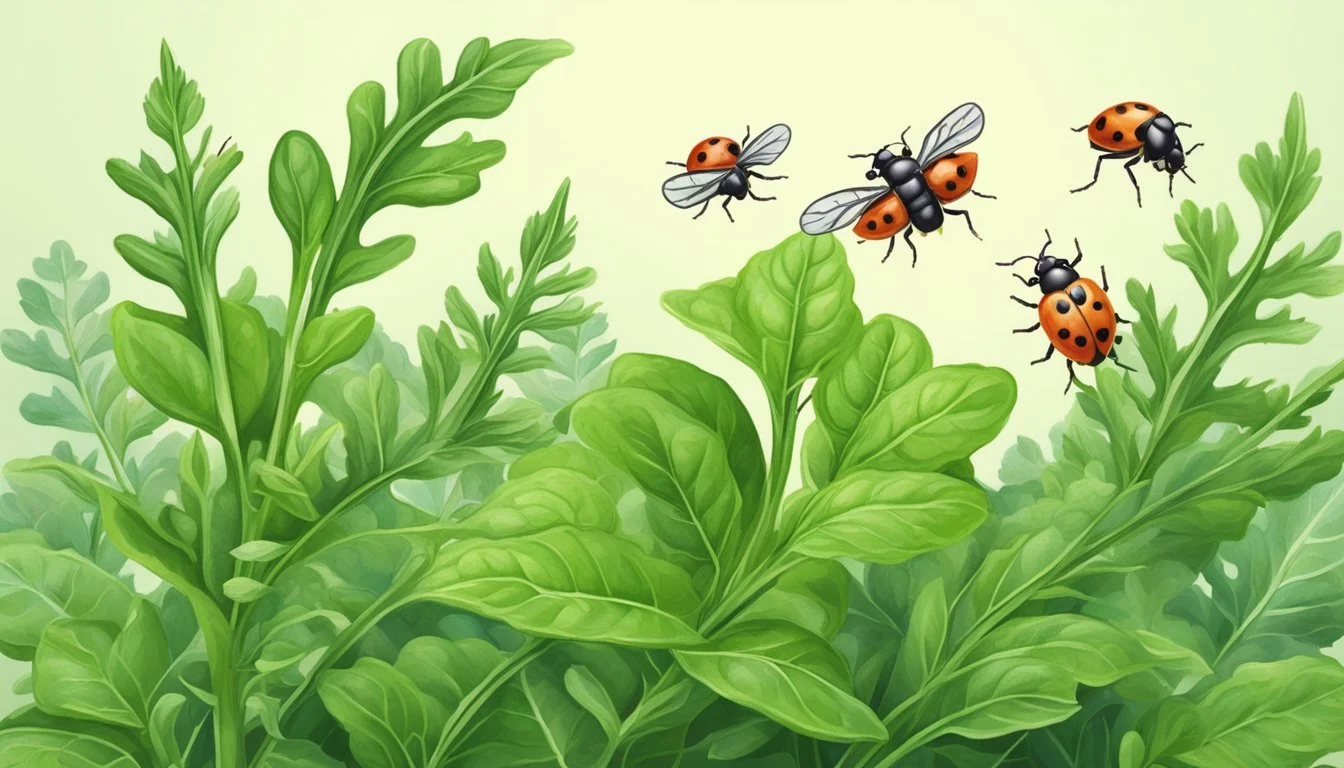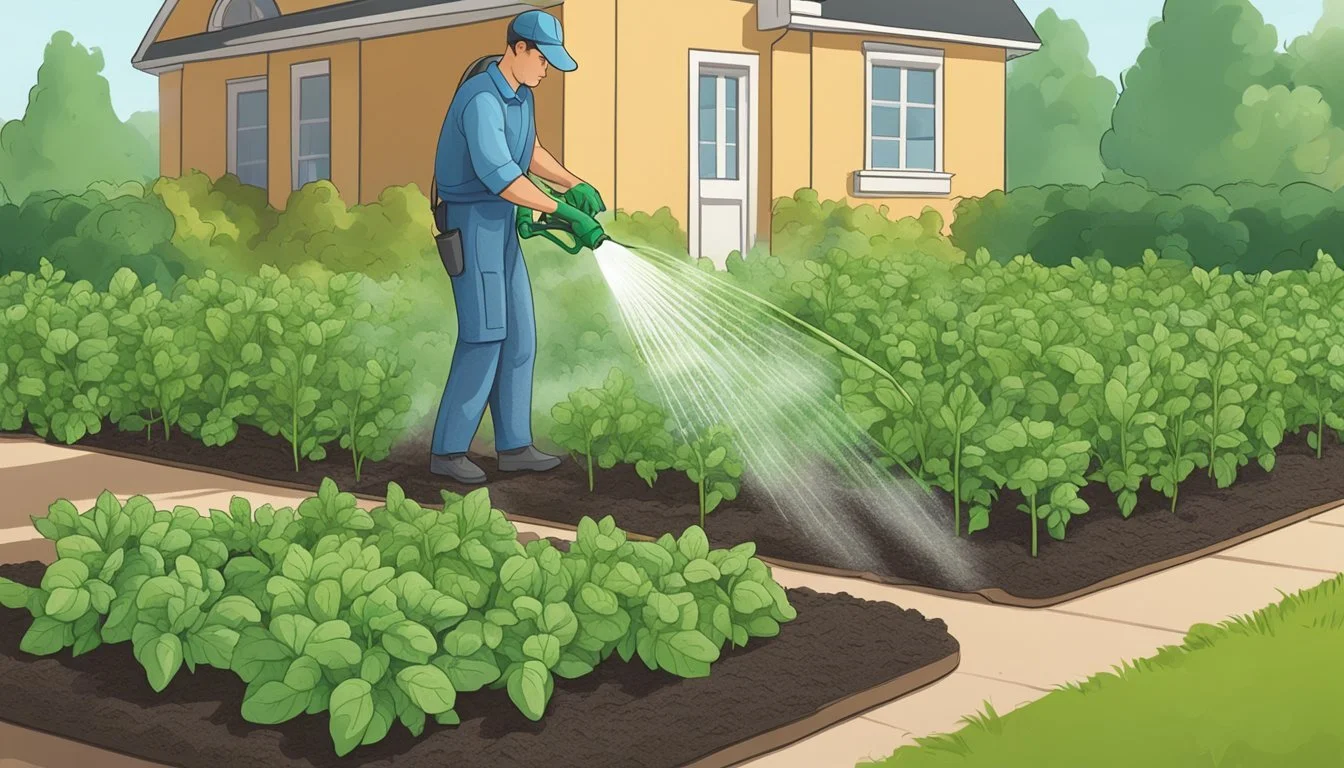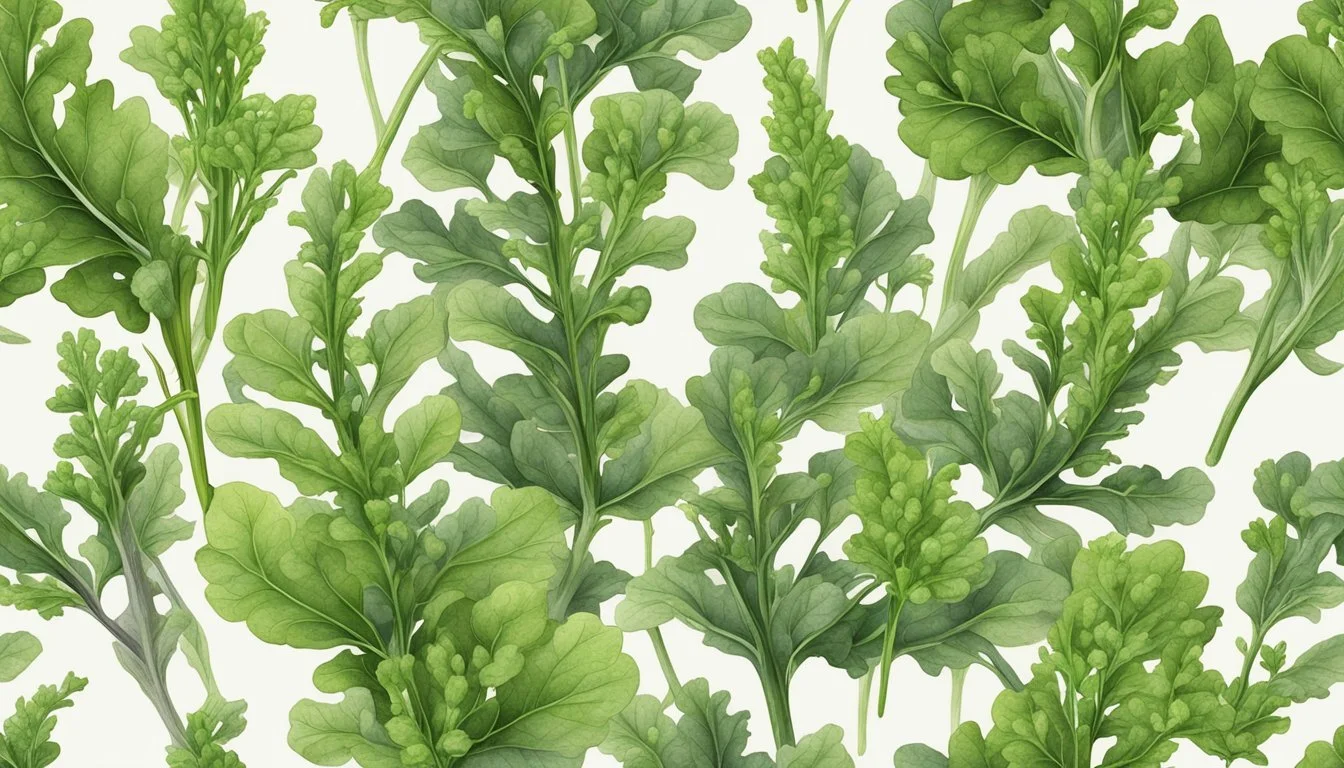Pest Control for Arugula
Effective Strategies for Healthy Greens
Arugula (how long does arugula last?), also recognized as rocket or roquette, is a peppery, nutritious leafy green often used in salads, sandwiches, and as a garnish. It's a favored choice for many gardeners due to its rapid growth and versatile use in a variety of dishes. Despite its hardiness, arugula can be vulnerable to various pests that can compromise its growth and yield. Effective pest control is crucial to cultivate a flourishing arugula crop and maintain the quality of the produce.
The common pests that pose a threat to arugula include aphids, flea beetles, and caterpillars, which can cause significant damage to the leaves and overall plant health. Prevention and control methods are important considerations for growers, as they aim to keep their arugula plants healthy. Implementing strategies such as regular plant inspection, companion planting, and the introduction of beneficial insects can deter pests and mitigate the damage they inflict.
Growing arugula requires not only good cultivation practices but also awareness of the potential for pest infestation. Adopting natural pest control methods can be an effective way to protect arugula crops without resorting to harsh chemicals. For more detailed guidance on managing common arugula pests, the information provided by Gardener's Path and ShunCy can help gardeners understand organic approaches to pest control.
Understanding Arugula
Arugula, commonly known as rocket, is a nutritious leafy green vegetable from the Brassicaceae family, which includes cabbage and kale. It is renowned for its peppery flavor and is a popular ingredient in salads.
Arugula Varieties
Arugula comes in several varieties, each with distinct characteristics. The wild arugula (Diplotaxis tenuifolia) has a more intense flavor and a perennial growing cycle, whereas cultivated arugula (Eruca vesicaria) is milder and usually harvested as an annual. Different varieties may have variations in leaf shape and texture, ranging from the common flat-leafed type to the more lobed and serrated options.
Nutritional Profile
Arugula is low in calories and fat but rich in essential nutrients. A serving typically provides:
Vitamins: A significant amount of vitamin K and vitamin C
Minerals: Calcium and potassium
Phytochemicals: Glucosinolates and antioxidants
These nutrients contribute to bone health, blood clotting, immune support, and may have anti-inflammatory effects.
Optimal Growing Conditions
Arugula thrives in well-drained soil with a neutral to slightly acidic pH. This leafy green prefers cooler climates and can be sown directly into the ground in early spring or late summer. While it requires sunlight, arugula can tolerate partial shade, making it versatile for various planting scenarios. Over- and underwatering should be avoided to protect the plant's health and vigor, thus reducing susceptibility to pests.
Site Preparation and Planting
Before planting arugula, one must ensure proper site preparation. This includes understanding the soil's pH, using the right sowing techniques, and accommodating for light and temperature needs. These steps are vital for a successful yield of this leafy green.
Soil Requirements and pH Levels
Arugula thrives in well-draining soil that's rich in organic matter. A soil with a pH level between 6.0 and 7.0 is ideal, which allows arugula to absorb necessary nutrients efficiently. Amending the soil with compost can improve drainage and add nutrients.
Sowing Techniques
Arugula seeds should be sown directly into the ground in early spring. Sowing seeds ¼ inch deep and about 1 inch apart in rows will ensure adequate space for growth. For a continuous harvest, practice successive planting every two to three weeks.
Light and Temperature
Arugula requires full sun to light shade to grow well, and temperatures between 45-65°F are optimal. Although arugula can tolerate light frost, growing it in temperatures that are too high will lead to early bolting. Therefore, planting in early spring allows for the best growing conditions before the heat of summer.
Arugula Growth and Maintenance
Proper growth and maintenance are crucial for the longevity and productivity of arugula crops. This includes ensuring the right balance of watering and nutrients, managing common diseases, and maintaining the plantation through thinning and weeding.
Watering and Nutrients
Arugula requires consistent moisture, especially when seedlings are establishing and during dry periods. Watering should be sufficient to keep the soil moist but not waterlogged. A balanced approach to fertilization can boost growth; a mix of compost and manure is recommended to enrich the soil.
Watering Needs Nutrient Requirements Even moisture Nitrogen-rich compost Avoid waterlogging Phosphorous Sensitive to drought Potassium
Common Diseases and Prevention
Arugula is prone to various diseases such as downy mildew and bacterial leaf spot. Prevention strategies include proper air circulation around plants and avoiding overhead watering that can increase humidity. Application of fungicides may be necessary, and one can explore organic options to mitigate disease issues.
Disease Prevention Methods Downy mildew Ensure good air flow Bacterial leaf spot Avoid water on foliage Fungal diseases Apply organic fungicides as required
Thinning and Weeding
After arugula seedlings have formed their first true leaves, they should be thinned out to about 6 to 8 inches apart. This spacing is important for air flow and growth space. Regular weeding is necessary to prevent competition for nutrients and resources, and mulching can help suppress weed growth.
Maintenance Task Tips Thinning Space out to 6-8 inches Weeding Remove weeds promptly; use mulch Mulching Helps retain moisture, suppresses weeds
Pest Control Strategies
Effective pest control is crucial for healthy arugula crops. This section explores specific strategies to address and manage pests, ensuring your plants are protected and thriving.
Identifying Common Pests
The first step in arugula pest control is to identify the culprits. Aphids and flea beetles are among the most common insects that feast on arugula. Aphids are small, soft-bodied insects that can be green, black, brown, or pink and are often found in clusters on the undersides of leaves. Flea beetles are small, jumping beetles that leave small holes in the foliage. Using sticky traps can help monitor these pests' activity levels in your garden.
Organic Pest Management
Organic methods prioritize the environment and beneficial insects. Incorporating companion planting, such as placing herbs that repel pests like mint or basil near arugula, can naturally deter pests. Handpicking is another direct approach to remove larger pests such as caterpillars and beetles. Encouraging beneficial insects like ladybugs, which prey on aphids, is an eco-friendly strategy. When infestations are significant, applying organic options like neem oil or insecticidal soap can effectively control pests without harming other insects or the environment. For more details, explore the approaches on Gardener's Path.
Chemical Control Methods
In cases where organic methods are insufficient, chemical insecticides may be necessary. It's essential to select pesticides specifically labelled for edible plants and follow the application instructions precisely. The use of chemicals should be a last resort, carefully timed to avoid affecting pollinators and other non-target wildlife. Always consider the impact on local ecosystems and adhere to recommended safety guidelines. For further reading on pesticide use, refer to agriculture.gov.capital.
Harvesting and Storing
Harvesting arugula at the right time and using proper techniques ensures maximum flavor and shelf-life. Storing it correctly is essential to maintaining the tender leaves' culinary quality after harvesting.
When to Harvest
Arugula reaches maturity typically within 4 to 6 weeks after planting the seedlings. They are ready to harvest when the leaves are tender, usually about 2 to 3 inches in length. It's best to pick the leaves while they are young and before the plant starts to flower, as this can lead to a bitter taste.
Harvesting Techniques
For harvesting, use clean, sharp scissors or a knife:
Cut the outer leaves first, leaving the center intact to allow the plant to continue growing.
Avoid pulling the plant, which can disturb the roots of adjacent plants.
Harvest in the cool morning hours when the plant's leaves are full of moisture and at their crispest.
Post-Harvest Handling
Proper post-harvest handling is crucial for extending the shelf life of arugula:
Wash the leaves gently in cold water to remove soil and pests.
Spin dry or pat the leaves with a paper towel.
Store the leaves in the refrigerator between damp paper towels inside a perforated plastic bag.
Consume within a few days for the best quality as arugula is highly perishable.
Using Arugula in Cooking
Arugula, known for its distinct peppery taste, is not only a versatile ingredient in the kitchen but also a rich source of vitamins A and C, folate, iron, potassium, and antioxidants. Its bold flavor and nutritional value make it a popular choice for enhancing various dishes.
Flavor Profile and Pairings
Arugula has a peppery and slightly bitter flavor that can transform the taste complexity of many dishes. It pairs exceptionally well with:
Citrus fruits: like lemon and orange, which help balance its spiciness.
Cheese: such as Parmesan or goat cheese, contrasting its bitterness.
Nuts: like pine nuts or walnuts, adding a toasty crunch.
Sweet fruits: such as pears or strawberries, to complement its peppery notes.
This green is an excellent garnish, bringing not only flavor but also a pop of color to dishes.
Incorporating into Dishes
Arugula is highly adaptable and can be used in various ways:
Salads: Often the foundation of salads, arugula can be mixed with other greens or served alone with a simple vinaigrette.
Sandwiches: Adds a nutritious kick and a spicy edge to sandwiches and wraps.
Pizzas: After baking, top pizza with fresh arugula for added texture and a nutrient boost.
Beyond these uses, arugula can be lightly sautéed as a side dish or included in pastas for its bold flavor and health benefits.
Growing Arugula in Containers
Growing arugula in containers offers a versatile way to cultivate this peppery salad green, also known as rocket or rucola. Appropriate container selection and thorough management are paramount for a successful harvest.
Container Selection
When selecting containers, one must ensure they support ample root growth and provide adequate drainage. Ideal containers for arugula should be at least 6-8 inches deep to accommodate the plant's roots. They can be made from plastic, clay, or metal, but it's essential that the bottom has multiple drainage holes. A well-drained soil mix fills the container, leaving about an inch of space below the rim for ease of watering.
Management of Container-Grown Arugula
To manage arugula in containers, consider the following points for optimal growth:
Soil: Use a high-quality potting mix that ensures well-drained soil conditions. Mixing in compost can enhance soil fertility.
Planting: Sow arugula seeds about 1/4 inch deep, spacing them approximately an inch apart. Arugula can be grown indoors if placed in a sunny spot or outdoors in a space receiving ample sunlight.
Watering: Regular watering is crucial; the soil should be kept evenly moist but not waterlogged. Containers dry out faster than ground soil, so monitor moisture levels closely.
Feeding: Apply a balanced liquid fertilizer every couple of weeks to support lush growth.
Thinning: Once seedlings emerge, thin them to prevent overcrowding, which could impede growth and increase susceptibility to pests.
By using containers, gardeners can easily move their arugula to optimize exposure to sunlight or to protect it from harsh weather conditions. Additionally, container gardening facilitates control over soil conditions, which can lead to healthier plants and a more bountiful crop of rucola.
Advanced Topics
In this section, we delve into the specialized aspects of arugula production, placing an emphasis on varietal selection, cutting-edge growth methods, and the role arugula plays in sustainable agricultural practices.
Hybrid and Heirloom Varieties
Arugula varieties are a crucial consideration for gardeners aiming for specific characteristics like size, flavor, and resilience. Hybrid arugula varieties often exhibit enhanced disease resistance and uniformity, making them suitable for gardeners who value consistency and high yield. On the other hand, heirloom varieties maintain traditional characteristics, such as the unique peppery taste arugula is known for, and can contribute to biodiversity in the garden.
Innovative Cultivation Techniques
They employ novel cultivation techniques to maximize arugula growth and maintain optimal health. Growing arugula using hydroponics allows for precise control over nutrients and avoids soil-borne diseases. Gardeners in areas with less-than-ideal soil often grow arugula in containers, which can be filled with a blend of potting soil and sand to ensure proper drainage. Integrated Pest Management (IPM) offers a systematic approach to pest control, balancing the need for pest management with environmental considerations.
Arugula in Sustainable Agriculture
In sustainable agricultural systems, arugula stands out as a nutritious salad green. It can be effectively cultivated in Brassicaceae companion planting schemes, benefiting from the pest-deterring properties of neighboring plants like radishes. Arugula thrives in full sun, but it is also tolerant of partial shade, which makes it versatile within crop rotations. The incorporation of arugula into cover cropping strategies can improve soil health and structure, contributing to the overarching goals of sustainable practice.
Troubleshooting Common Issues
When cultivating arugula, gardeners may encounter issues such as unexpected bitterness, signs of plant stress, or crop failure. By understanding these challenges and applying the right techniques, one can maintain the flavor and health of their arugula plants.
Dealing with Bitterness
Arugula naturally has a peppery taste, but excessive bitterness can result from several factors. High temperature and insufficient watering can increase the bitterness of the leaves. Ensuring consistent soil moisture and planting in an area with full sun to light shade helps manage flavor. Succession planting allows for a continuous harvest before the plant bolts and becomes too bitter.
Addressing Plant Stress
Stressed arugula plants might exhibit curling leaves, wilting, and the presence of holes caused by pests like slugs and snails. Effective stress management includes maintaining proper pH and calcium levels in the soil, as well as regular watering to avoid root rot. Insecticides such as pyrethrin can help control pests, while introducing predators like lacewings assists in the natural reduction of pest populations.
Preventive Measures for Crop Failure
Crop failure can often be prevented through careful cultivation and monitoring. Regularly inspect plants for signs of pests, such as sap-sucking larvae, and apply relevant pesticides or natural solutions as needed. To ensure a steady yield, practice succession planting, using a new packet of seeds every few weeks. Companion plants, such as mustard greens, may help deter certain pests. It's crucial to ensure plants are watered properly and receive adequate sunlight and nutrients for successful germination and growth.
Propagation and Seed Saving
Successful propagation and seed saving of arugula ensures a continuous supply of quality seeds for future planting. Mastery of these techniques can lead to strong germination rates and robust crops.
Seed Harvesting
To harvest arugula seeds, one must wait for the plant to bolt and mature. This entails allowing the flowers to develop and pollinate, followed by the formation of seed pods. Once the pods appear dry and begin to brown, they should be carefully cut from the plant. It’s crucial to harvest before the pods open naturally to prevent accidental seed dispersal.
Storing Seeds for Future Planting
It's imperative to store arugula seeds properly to maintain their viability for germination. After collecting, seeds must be thoroughly dried to prevent mold. Storing them in a cool, dark place, typically in a paper packet or cloth bag, can protect them from moisture and light. Writing the harvest date on the packet ensures one can track seed longevity.
Creating a Seed Bank
A seed bank serves as a reservoir of arugula diversity and genetic variation, offering protection against plant diseases and environmental changes. By saving seeds from plants that have thrived in particular conditions, they can cultivate more resilient arugula varieties over time. An organized seed bank should catalogue seeds by variety and date of collection to maintain high-quality seed stocks.
Frequently Asked Questions
Effective pest management is crucial for the health of arugula crops. Addressing common concerns, this section provides targeted advice for identifying and dealing with arugula pests.
How can I identify and treat common pests affecting arugula (rocket)?
Arugula is susceptible to pests like flea beetles and aphids. Look for small holes in leaves and a sticky residue. To treat these pests, use natural methods such as introducing beneficial insects or applying neem oil.
Are there safe practices to prevent bugs from infesting arugula in the garden?
Prevention is key in keeping bugs away from arugula. Ensure healthy soil and crop rotation. Use companion planting and maintain garden hygiene to deter pests from settling.
What techniques are effective for managing aphids on arugula crops?
Managing aphids requires vigilance. Introduce predatory insects like ladybugs, or apply water sprays and insecticidal soaps. It's also beneficial to encourage natural aphid predators by planting flowers that attract them.
Can you still consume arugula leaves that have holes or black spots?
Arugula leaves with holes or black spots may be aesthetically unappealing but are often still edible after thorough washing. However, it's important to ascertain the extent of the damage; if the leaf is diseased, it's best to discard it.
What are some companion plants that can help protect arugula against pests?
Companion plants like basil and mint can help repel pests due to their strong scents. Planting arugula near such herbs can minimize the likelihood of infestation.
What is causing the holes in my arugula leaves, and how can I address it?
Holes in arugula leaves are typically caused by insect larvae or adult insects like caterpillars and flea beetles. To address this, cover crops with floating row covers or apply organic pesticides carefully following manufacturer instructions.








